Abstract
The CD4 molecule, expressed by T cells restricted by class II major histocompatibility complex (MHC) molecules, is believed to play a role in T-cell activation. We have previously suggested that CD4 interacts with the T-cell receptor for antigen (TCR) and with class II MHC and that this dual interaction stabilizes the bond between the TCR and antigen in association with MHC. To investigate the contribution of CD4-TCR interaction, we have used the murine monoclonal anti-TCR V beta 8 antibody F23.1 to activate cloned T cells. Weak activation by soluble biotinylated F23.1 was markedly enhanced by crosslinking with either avidin or with anti-immunoglobulin (anti-Ig). The monoclonal anti-L3T4 antibody GK1.5, which normally inhibits the activation induced by F23.1, did not inhibit when GK1.5 and F23.1 were coaggregated on T cells by anti-Ig, and in many experiments activation was enhanced. Coaggregation of anti-Thy-1.2, anti-H-2Kk, or anti-LFA-1 with F23.1 also enhanced T-cell activation, although, unlike GK1.5, these antibodies in soluble form had no effect on the response to F23.1. These results are consistent with a model for T-cell activation that proposes a primary interaction between L3T4 and the TCR to stabilize TCR complexes and so to enhance T-cell activation. A related but less specific accessory role for other T-cell surface molecules is also suggested. We propose that the cellular interaction that leads to physiological T-cell activation not only achieves TCR ligation but also promotes through their ligation or redistribution the interaction of other T-cell surface molecules, all of which contribute to the overall strength of the activation signal.
Full text
PDF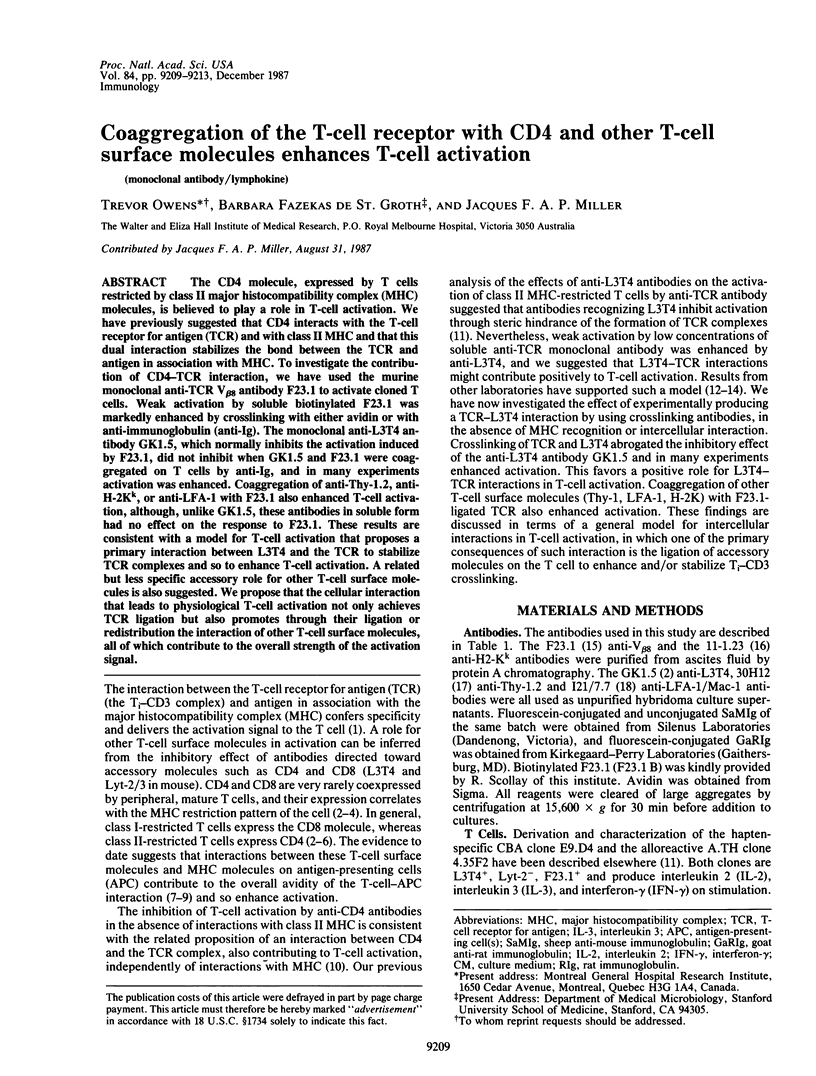
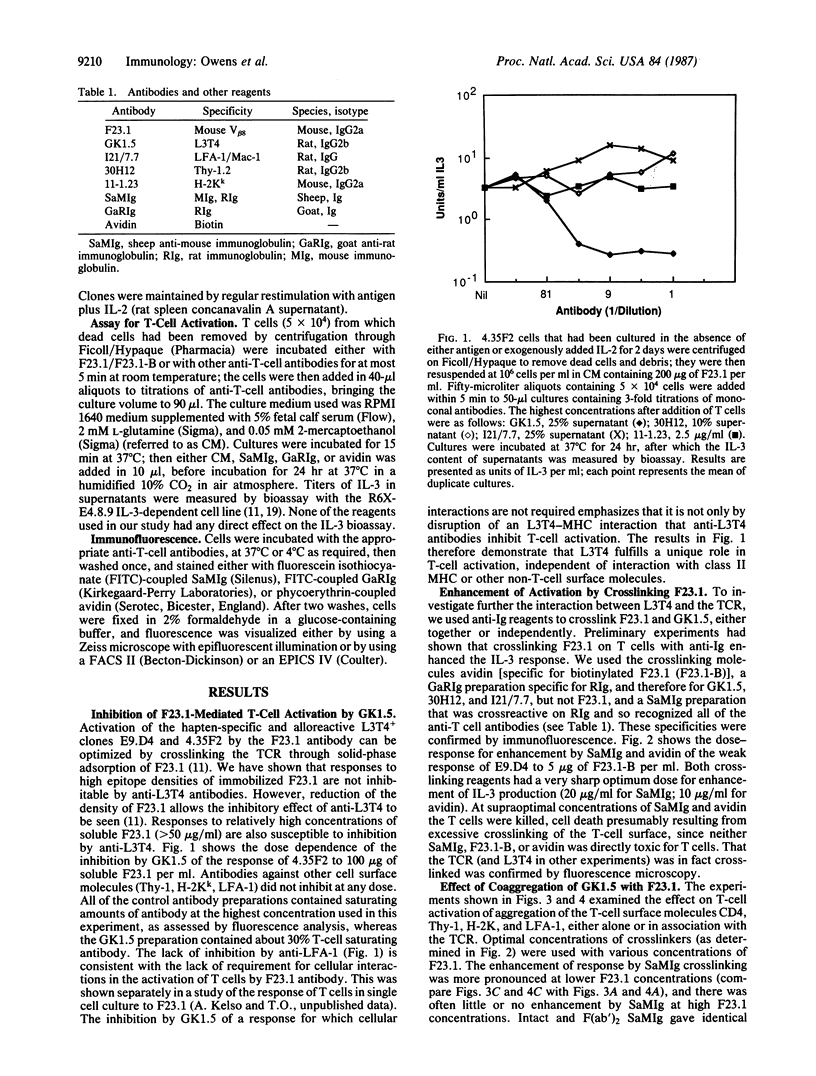
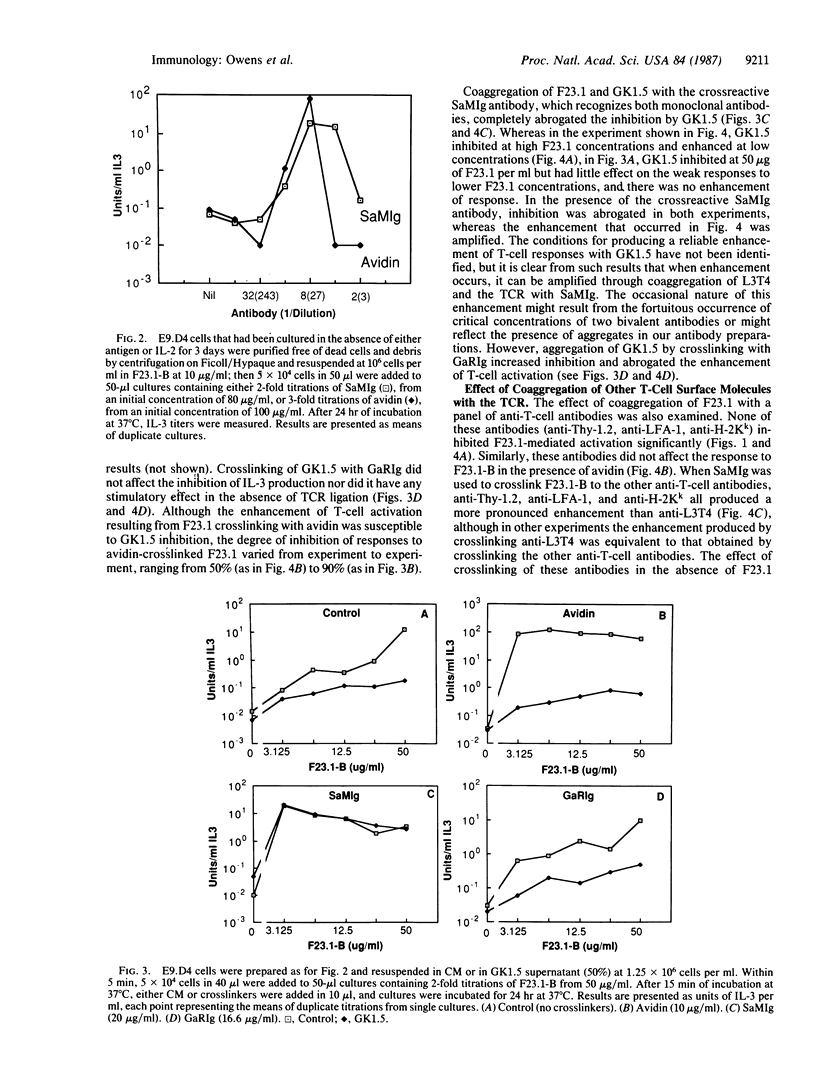
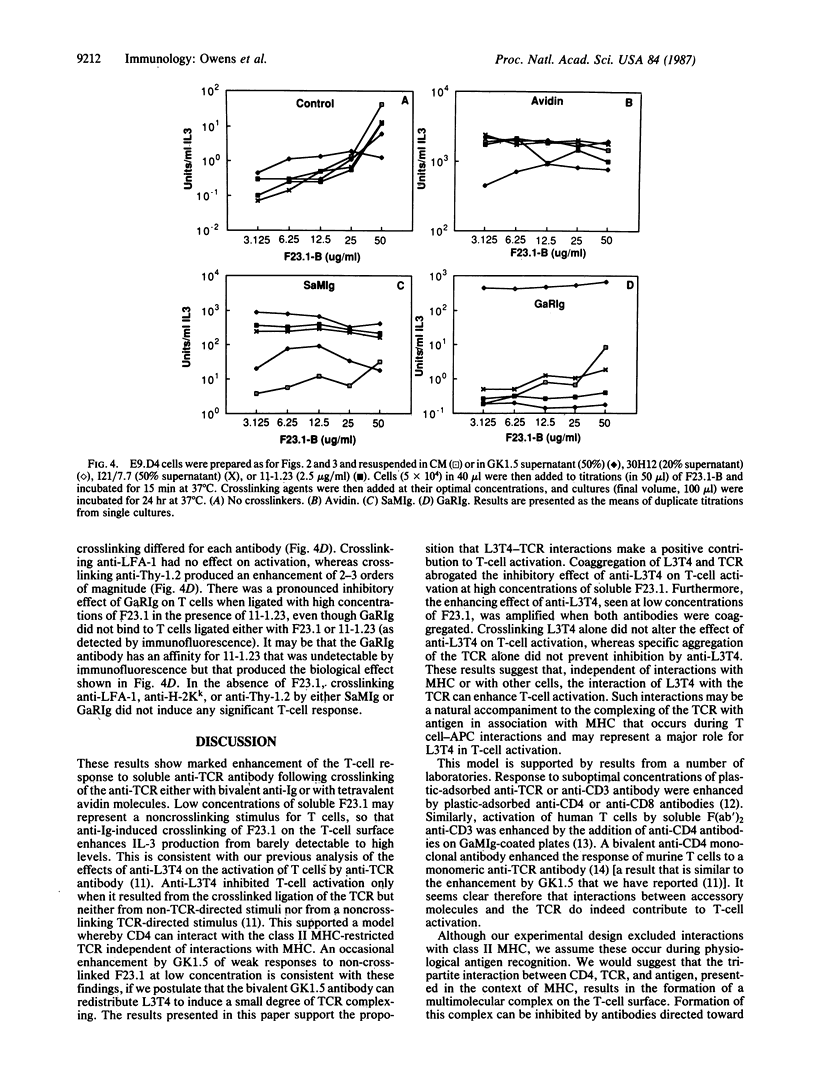
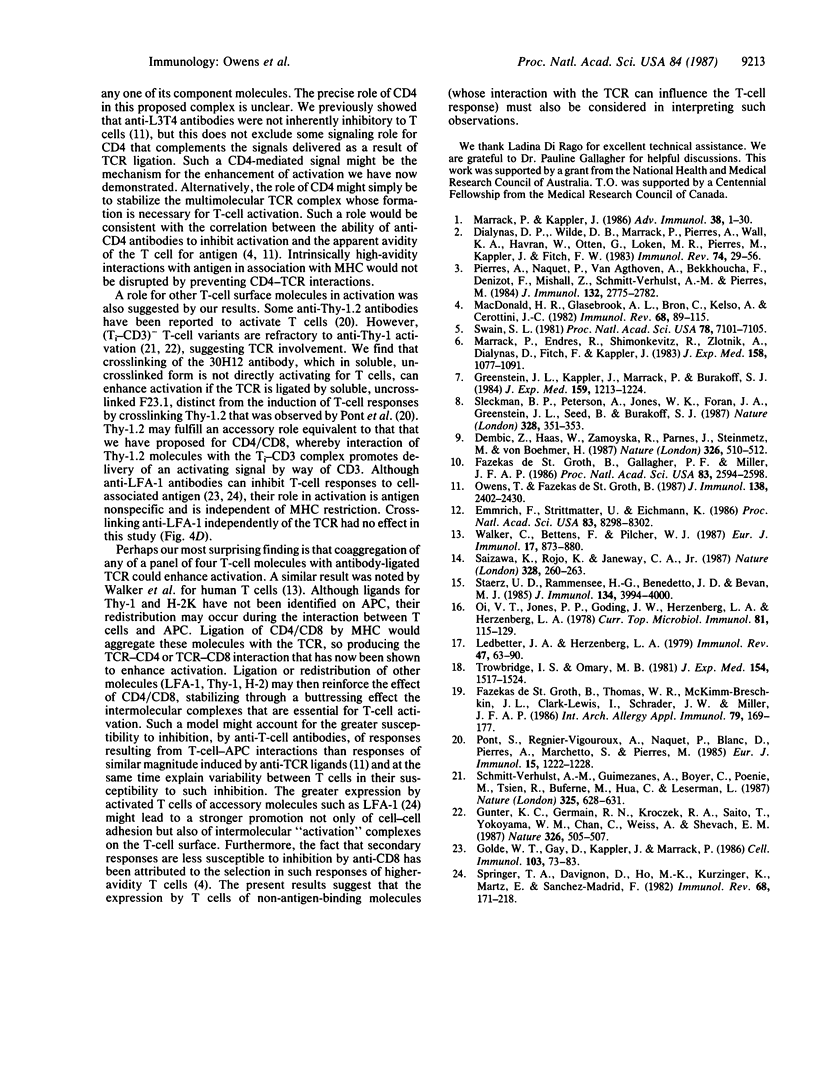
Selected References
These references are in PubMed. This may not be the complete list of references from this article.
- Dembić Z., Haas W., Zamoyska R., Parnes J., Steinmetz M., von Boehmer H. Transfection of the CD8 gene enhances T-cell recognition. Nature. 1987 Apr 2;326(6112):510–511. doi: 10.1038/326510a0. [DOI] [PubMed] [Google Scholar]
- Dialynas D. P., Wilde D. B., Marrack P., Pierres A., Wall K. A., Havran W., Otten G., Loken M. R., Pierres M., Kappler J. Characterization of the murine antigenic determinant, designated L3T4a, recognized by monoclonal antibody GK1.5: expression of L3T4a by functional T cell clones appears to correlate primarily with class II MHC antigen-reactivity. Immunol Rev. 1983;74:29–56. doi: 10.1111/j.1600-065x.1983.tb01083.x. [DOI] [PubMed] [Google Scholar]
- Emmrich F., Strittmatter U., Eichmann K. Synergism in the activation of human CD8 T cells by cross-linking the T-cell receptor complex with the CD8 differentiation antigen. Proc Natl Acad Sci U S A. 1986 Nov;83(21):8298–8302. doi: 10.1073/pnas.83.21.8298. [DOI] [PMC free article] [PubMed] [Google Scholar]
- Fazekas de St Groth B., Gallagher P. F., Miller J. F. Involvement of Lyt-2 and L3T4 in activation of hapten-specific Lyt-2+ L3T4+ T-cell clones. Proc Natl Acad Sci U S A. 1986 Apr;83(8):2594–2598. doi: 10.1073/pnas.83.8.2594. [DOI] [PMC free article] [PubMed] [Google Scholar]
- Fazekas de St Groth B., Thomas W. R., McKimm-Breschkin J. L., Clark-Lewis I., Schrader J. W., Miller J. F. P cell stimulating factor release: a useful assay of T cell activation in vitro. Int Arch Allergy Appl Immunol. 1986;79(2):169–177. doi: 10.1159/000233966. [DOI] [PubMed] [Google Scholar]
- Golde W. T., Gay D., Kappler J., Marrack P. The role of LFA-1 in class II restricted, antigen-specific T-cell responses. Cell Immunol. 1986 Nov;103(1):73–83. doi: 10.1016/0008-8749(86)90069-9. [DOI] [PubMed] [Google Scholar]
- Greenstein J. L., Kappler J., Marrack P., Burakoff S. J. The role of L3T4 in recognition of Ia by a cytotoxic, H-2Dd-specific T cell hybridoma. J Exp Med. 1984 Apr 1;159(4):1213–1224. doi: 10.1084/jem.159.4.1213. [DOI] [PMC free article] [PubMed] [Google Scholar]
- Gunter K. C., Germain R. N., Kroczek R. A., Saito T., Yokoyama W. M., Chan C., Weiss A., Shevach E. M. Thy-1-mediated T-cell activation requires co-expression of CD3/Ti complex. Nature. 1987 Apr 2;326(6112):505–507. doi: 10.1038/326505a0. [DOI] [PubMed] [Google Scholar]
- Ledbetter J. A., Herzenberg L. A. Xenogeneic monoclonal antibodies to mouse lymphoid differentiation antigens. Immunol Rev. 1979;47:63–90. doi: 10.1111/j.1600-065x.1979.tb00289.x. [DOI] [PubMed] [Google Scholar]
- MacDonald H. R., Glasebrook A. L., Bron C., Kelso A., Cerottini J. C. Clonal heterogeneity in the functional requirement for Lyt-2/3 molecules on cytolytic T lymphocytes (CTL): possible implications for the affinity of CTL antigen receptors. Immunol Rev. 1982;68:89–115. doi: 10.1111/j.1600-065x.1982.tb01061.x. [DOI] [PubMed] [Google Scholar]
- Marrack P., Endres R., Shimonkevitz R., Zlotnik A., Dialynas D., Fitch F., Kappler J. The major histocompatibility complex-restricted antigen receptor on T cells. II. Role of the L3T4 product. J Exp Med. 1983 Oct 1;158(4):1077–1091. doi: 10.1084/jem.158.4.1077. [DOI] [PMC free article] [PubMed] [Google Scholar]
- Marrack P., Kappler J. The antigen-specific, major histocompatibility complex-restricted receptor on T cells. Adv Immunol. 1986;38:1–30. doi: 10.1016/s0065-2776(08)60005-x. [DOI] [PubMed] [Google Scholar]
- Oi V. T., Jones P. P., Goding J. W., Herzenberg L. A., Herzenberg L. A. Properties of monoclonal antibodies to mouse Ig allotypes, H-2, and Ia antigens. Curr Top Microbiol Immunol. 1978;81:115–120. doi: 10.1007/978-3-642-67448-8_18. [DOI] [PubMed] [Google Scholar]
- Pierres A., Naquet P., Van Agthoven A., Bekkhoucha F., Denizot F., Mishal Z., Schmitt-Verhulst A. M., Pierres M. A rat anti-mouse T4 monoclonal antibody (H129.19) inhibits the proliferation of Ia-reactive T cell clones and delineates two phenotypically distinct (T4+, Lyt-2,3-, and T4-, Lyt-2,3+) subsets among anti-Ia cytolytic T cell clones. J Immunol. 1984 Jun;132(6):2775–2782. [PubMed] [Google Scholar]
- Pont S., Regnier-Vigouroux A., Naquet P., Blanc D., Pierres A., Marchetto S., Pierres M. Analysis of the Thy-1 pathway of T cell hybridoma activation using 17 rat monoclonal antibodies reactive with distinct Thy-1 epitopes. Eur J Immunol. 1985 Dec;15(12):1222–1228. doi: 10.1002/eji.1830151215. [DOI] [PubMed] [Google Scholar]
- Saizawa K., Rojo J., Janeway C. A., Jr Evidence for a physical association of CD4 and the CD3:alpha:beta T-cell receptor. Nature. 1987 Jul 16;328(6127):260–263. doi: 10.1038/328260a0. [DOI] [PubMed] [Google Scholar]
- Schmitt-Verhulst A. M., Guimezanes A., Boyer C., Poenie M., Tsien R., Buferne M., Hua C., Leserman L. Pleiotropic loss of activation pathways in a T-cell receptor alpha-chain deletion variant of a cytolytic T-cell clone. Nature. 1987 Feb 12;325(6105):628–631. doi: 10.1038/325628a0. [DOI] [PubMed] [Google Scholar]
- Sleckman B. P., Peterson A., Jones W. K., Foran J. A., Greenstein J. L., Seed B., Burakoff S. J. Expression and function of CD4 in a murine T-cell hybridoma. Nature. 1987 Jul 23;328(6128):351–353. doi: 10.1038/328351a0. [DOI] [PubMed] [Google Scholar]
- Springer T. A., Davignon D., Ho M. K., Kürzinger K., Martz E., Sanchez-Madrid F. LFA-1 and Lyt-2,3, molecules associated with T lymphocyte-mediated killing; and Mac-1, an LFA-1 homologue associated with complement receptor function. Immunol Rev. 1982;68:171–195. doi: 10.1111/j.1600-065x.1982.tb01064.x. [DOI] [PubMed] [Google Scholar]
- Staerz U. D., Rammensee H. G., Benedetto J. D., Bevan M. J. Characterization of a murine monoclonal antibody specific for an allotypic determinant on T cell antigen receptor. J Immunol. 1985 Jun;134(6):3994–4000. [PubMed] [Google Scholar]
- Swain S. L. Significance of Lyt phenotypes: Lyt2 antibodies block activities of T cells that recognize class 1 major histocompatibility complex antigens regardless of their function. Proc Natl Acad Sci U S A. 1981 Nov;78(11):7101–7105. doi: 10.1073/pnas.78.11.7101. [DOI] [PMC free article] [PubMed] [Google Scholar]
- Trowbridge I. S., Omary M. B. Molecular complexity of leukocyte surface glycoproteins related to the macrophage differentiation antigen Mac-1. J Exp Med. 1981 Nov 1;154(5):1517–1524. doi: 10.1084/jem.154.5.1517. [DOI] [PMC free article] [PubMed] [Google Scholar]
- Walker C., Bettens F., Pichler W. J. Activation of T cells by cross-linking an anti-CD3 antibody with a second anti-T cell antibody: mechanism and subset-specific activation. Eur J Immunol. 1987 Jun;17(6):873–880. doi: 10.1002/eji.1830170622. [DOI] [PubMed] [Google Scholar]


